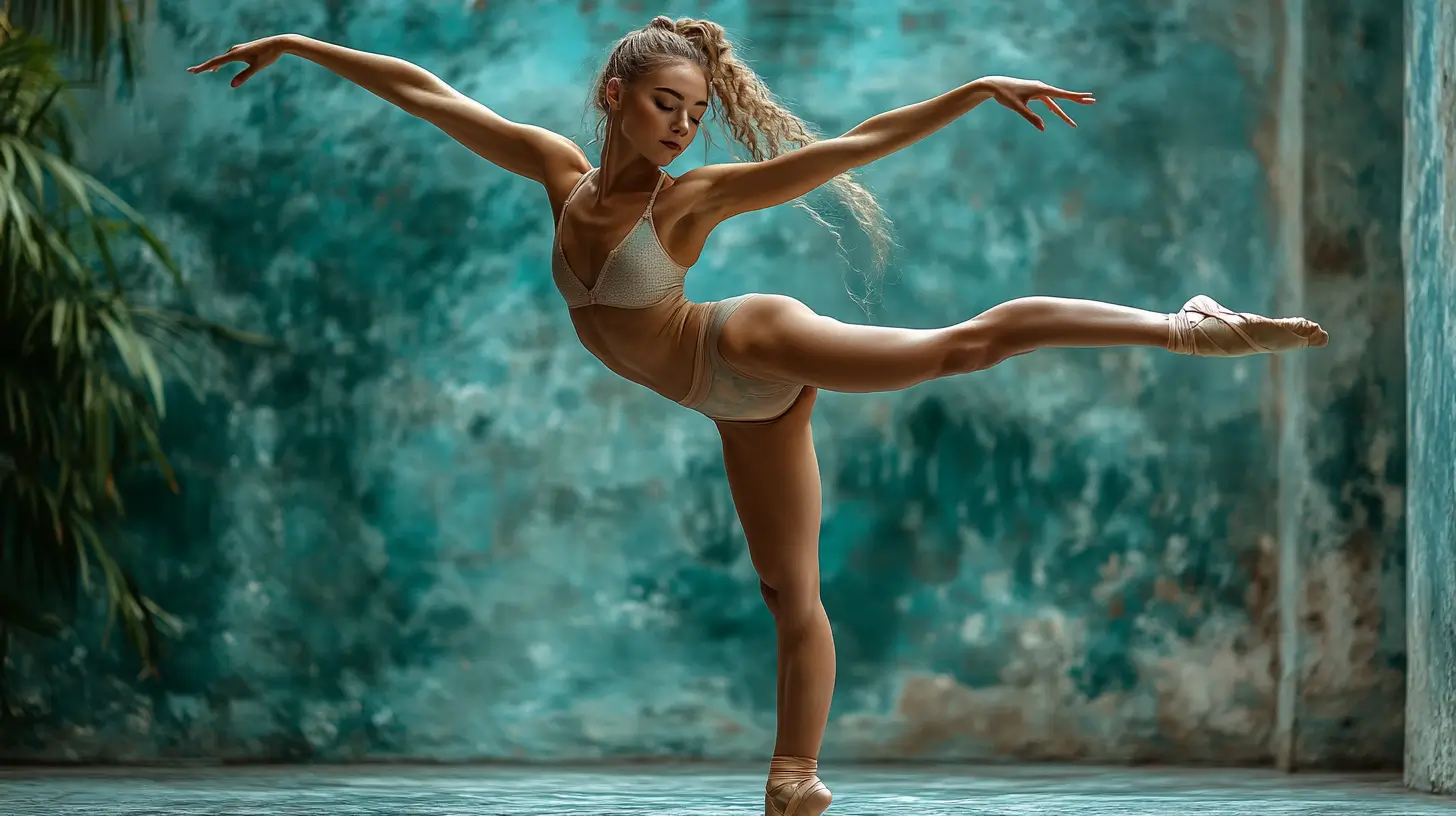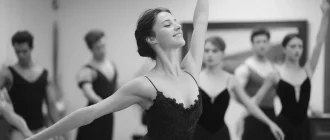Looking to perfect your ballerina pirouette? This guide offers essential tips and techniques to help you align your body, strengthen your supporting leg, and maintain balance during your turns. Discover practical exercises and methods to enhance your ballerina pirouette and performance.
Key Takeaways
- Mastering the pirouette requires focus on alignment, balance, and control; consistent practice is essential for improvement.
- Strengthening the supporting leg and engaging the core is critical for executing clean, effortless pirouettes during turns.
- Utilizing video tutorials and sharing progress with the dance community can enhance technique and motivate constructive feedback.
| Category | Details |
|---|---|
| Preparation | – Foot Position: Start with feet in a strong fourth position, with weight centered. – Core Engagement: Engage core muscles for stability. |
| Spotting | Focus Point: Keep your eyes on a specific spot. – Head Movement: Remove your head to the same spot after each rotation to maintain balance. |
| Arms | – Rounded Shape: Arms should be rounded, not too close or far from the body. Synchronization: Arms should move smoothly in sync with the body. |
| Leg Position (Passé) | – Raised Leg: Keep the working leg in a high passé position with toes pointed and knee lifted. – Alignment: Ensure the knee faces outwards for a proper turn. |
| Balance & Center | – Alignment: Keep your shoulders over your hips and your hips over your supporting leg. – Weight Distribution: Shift weight slightly forward for balance. |
| Executing the Turn | – Push-Off: Use a controlled push from the back leg, but not too forceful. – Control Speed: Engage muscles to control the turning speed. |
| Common Mistakes | – Over-Rotation: Avoid throwing arms or leaning forward. – Weak Spotting: Not spotting effectively can lead to dizziness and instability. |
| Practice Drills | – Half-Turns: Start with half-turns to build confidence. Slow Pirouettes: Practice slow pirouettes to master control and perfect your form. |
| Strengthening Exercises | Core exercises, such as planks, leg raises, and Pilates, help improve core strength. – Ankle Stability: Use resistance bands to strengthen ankles. |
| Tips for Improvement | – Video Feedback: Record your turns to analyze posture and alignment. – Consistency: Practice consistently, starting with single turns and advancing to doubles or triples. |
Understanding the Pirouette
A pirouette is a fundamental ballet technique highlighting alignment, balance, and control. It showcases a ballet dancer’s technical proficiency and grace through precise, clean rotations. The beauty of a pirouette lies in its precision, the body’s alignment, the balance throughout the turn, and the control that ensures smooth execution.
Executing a single or double pirouette demonstrates mastery over one’s body, requiring balance on one leg while turning. This move tests alignment and control. Mastering clean pirouettes requires dedication and consistent practice. Each attempt brings you closer to perfection, making every minute spent in practice worthwhile.
Understanding the pirouette means recognizing the importance of foundational elements. Proper alignment positions your body for the turn without losing balance. Maintaining balance ensures the turn remains steady, while control allows for smooth, graceful rotations, showcasing your technical skill.
Progress in mastering the pirouette requires patience, perseverance, and learning from each attempt. Embrace the process; with each turn, you’ll grow more confident and proficient in this beautiful ballet move.
The Role of the Supporting Leg
The supporting leg is pivotal in executing a pirouette, needing to remain strong and stable to facilitate and perform the turn. A weak leg can result in unsafe turns and loss of balance, highlighting the importance of strengthening this important part of your body.
Exercises like side planks and single-leg bridges are excellent for enhancing the stability of the supporting leg. These exercises build strength and help maintain the desired position of the retiré leg during a pirouette. A strong supporting leg ensures body alignment and smooth, controlled turns.
Coordination between arms and legs is vital for a seamless pirouette. Achieving this harmony involves practice and focus. When lifting into the retiré position, your arms and legs should move together to maintain balance and control. Proper alignment and strong coordination will improve your pirouette execution, making your turns look effortless and graceful.
Mastering the Turn: Key Techniques

Mastering the turn in a pirouette involves precise techniques. Begin in the fourth position with legs straight and eyes focused on a fixed point. This focus, spotting, is crucial for maintaining balance during the turn. Keep your eyes on the end and snap your head around quickly to refocus with each rotation. Practicing spotting can significantly enhance pirouette performance.
Engaging the core maintains form throughout the turn. A tight core keeps the body straight and aligned, preventing unnecessary movements that could disrupt the turn. Dancers often find core-strengthening drills effective for improving coordination and technique. Avoid pre-emptive movements to ensure you remain balanced.
Pirouettes can be performed ‘en dehors’ (away from the supporting leg) or ‘en dedans’ (toward the supporting leg with one leg down). Regardless of direction, key elements remain the same: proper spotting, body alignment, and a strong core. The technique involves a person making a complete 360-degree turn on one leg while maintaining balance and grace.
A pirouette should finish with a graceful return to the fourth position, leaving a positive impression on the audience. This final touch showcases your control and elegance, completing the turn with finesse. Practicing Theseques will significantly improve your pirouette execution, making your turns more precise and graceful.
Focusing on these essential aspects allows you the time to learn and master the art of turning with precision and elegance. Every turn is an opportunity to refine your technique and showcase your artistry. Keep practicing, and soon, your pirouettes will testify to your dedication and skill.
Improving Your Balance

Improving balance is crucial for performing a pirouette, as it emphasizes a dancer’s ability to maintain proper posture and rotation. Strengthening the core is key to maintaining balance and control. Core exercises such as planks, bridges, and side planks are vital for building strength.
Practicing relevés can enhance stability by focusing on rising onto the balls of your feet while maintaining a strong demi-plié in the supporting leg. Exercises like dévéloppé à la seconde improve balance by strengthening the supporting leg, eventually building the necessary strength and stability for turns.
Proper alignment during turns involves maintaining a strong line from the head through the spine to the supporting leg. Integrating core strength with proper posture allows for better stability and balance. Spotting during a pirouette helps maintain balance and avoid dizziness. Focusing on these elements improves balance, allowing for more confident and precise pirouettes.
Using Quality Threads and Canvas
Using quality materials directly impacts dancers’ practice and performance. Investing in durable fabrics reduces wear and tear, leading to long-term savings. High-quality materials from Plum Stitchery offer better durability, comfort, and support, enhancing performance.
Quality materials provide ballet dancers with support and comfort during practice and performances. Comfortable, durable fabrics allow dancers to focus on technique without distractions. Plum Stitchery products receive positive reviews for durability and support, making them a valuable investment for ballet.
Choosing high-quality threads and a canvas kit ensures practice attire and performance costumes are comfortable and long-lasting. This investment enhances performance and provides peace of mind, knowing attire has threads and canvas kits to withstand the rigors of practice and performance.
Learning from Videos
Video tutorials are invaluable resources for improving pirouette technique. For example, a tutorial by Veronica K teaches beginner dancers how to perform an outward pirouette step by step, breaking down the mechanics, body alignment, and momentum.
The ‘Ballet For All’ channel offers a playlist focused on turns and pirouettes, covering essential techniques from spotting to performing multiple pirouettes. One video provides beginner tips on executing pirouettes, helping dancers build a solid foundation. Incorporating these resources into practice routines can greatly enhance your ability to master pirouettes.
Videos on common pirouette mistakes provide insights into refining techniques effectively. Learning from these videos allows dancers to visualize correct techniques and avoid common errors. Integrating these visual learning tools into practice can accelerate progress and improve results.
Sharing Your Progress
Documenting your progress on Instagram can inspire others. Use relevant hashtags like #BalletCommunity and #PirouetteProgress to connect and share more with fellow dancers and receive constructive feedback. Engaging with the dance community fosters a sense of belonging and provides a platform for sharing tips, information, and experiences.
Providing and receiving feedback within the community is essential for improvement, success, and motivation. Sharing successes and challenges can inspire others and help you stay motivated. Documenting your progress allows you to track improvements, review them, share your achievements, and celebrate your successes.
Sharing information about your journey on social media can lead to new opportunities and connections within the dance community. It’s a great way to stay engaged and motivated while learning from others’ experiences and successes. Don’t hesitate to share your pirouette progress and join the vibrant online dance community.
Reviews and Feedback
Reviews and feedback are crucial for refining pirouette techniques. Instructional videos recommended by dancers provide insights and constructive criticism. Sharing pirouette progress on Instagram fosters community feedback and support through relevant hashtags.
Many dancers praise Plum Stitchery products for their durability and support, enhancing performance during pirouette practice. Using high-quality materials allows dancers to focus on technique without the distraction of uncomfortable or worn-out attire.
Leave reviews and share information about your experiences to help others find the best resources and products for their practice. Reading reviews from fellow dancers provides valuable information and can share insights that can enhance your learning and training. Engaging with the community and sharing feedback contributes to a supportive and collaborative environment for all dancers.
Summary
Mastering the pirouette involves understanding the fundamental elements, strengthening the supporting leg, and practicing key techniques. Improving balance and using quality materials play a significant role in enhancing performance. Learning from videos and sharing your progress with the dance community can provide valuable feedback and add motivation.
Dedication and consistent practice are essential for mastering the pirouette. By focusing on the tips and techniques discussed, you can improve your pirouette execution and showcase your artistry and skill. Embrace the journey, and let your passion for dance drive you toward achieving perfection in your pirouettes.
Frequently Asked Questions
What is the most important element in executing a perfect pirouette?
To execute a perfect pirouette, achieving proper alignment is essential for clean rotations while maintaining balance and control to ensure stability throughout the turn.
How can I strengthen my supporting leg for better pirouettes?
Incorporate side planks and single-leg bridges into your training routine to strengthen your supporting leg for better pirouettes. These will improve your stability and strength, which are crucial for executing controlled pirouettes.
What are some key techniques for improving my pirouette?
To improve your pirouette, focus on proper spotting, engaging your core, maintaining body alignment, and eliminating pre-emptive movements. Consistent practice of these techniques will significantly enhance your execution.
How can video tutorials help me improve my pirouette technique?
Video tutorials are valuable for enhancing your pirouette technique as they visually break down the mechanics, including body alignment and momentum. This clear guidance helps you identify and correct common mistakes effectively.
Why is it important to use quality materials like those from Plum Stitchery?
Using quality materials and threads, like those from Plum Stitchery, is crucial as they provide superior durability, comfort, and support, ultimately enhancing your dance performance and prolonging the life of the threads in your practice attire.
What muscles should I engage first to improve balance in pirouettes?
Focus on deep core stabilisers, the gluteus medius and the turnout muscles around the hip; research shows dancers rely on strong medio-lateral control to keep the centre of pressure steady during single-leg turns, which translates to a steadier pirouette axis.
How can I strengthen my pirouette technique while away from the studio?
Integrate single-leg relevé holds, passé balances, and resisted arabesque lifts with a theraband to mimic the loading pattern of a turn; these drills build ankle stiffness and core–hip coordination, the two physical qualities most correlated with successful multiple rotations.
Which latest pirouette drills are helping dancers achieve consistent triples in 2025?
Dancers are incorporating proprioceptive “eyes-closed” drills and low-friction turn discs to sharpen vestibular response and refine spotting rhythm—both methods emerged in 2024–25 balance-training studies and have been adopted by online masterclasses this season.
How does correct spotting reduce dizziness and improve stability?
A rapid, rhythmical head snap re-anchors the visual system; faculty at the School of American Ballet coach dancers to count “one-two-land,” synchronising head tempo with rotation speed to stabilise the inner-ear/vision feedback loop.
Why do different ballet schools teach distinct pirouette preparations?
Preparations reflect each school’s stylistic priorities—French épaulement, Balanchine speed, or English line—and condition the body to reproduce those aesthetics on stage, so technique classes embed school-specific habits from the first quarter-turn exercises.
What sets the Paris Opera Ballet School’s pirouette approach apart?
The POB School favours a high retiré with pronounced épaulement and a slightly lifted heel in fourth-position preparation. It encourages dancers to keep their weight forward over the first metatarsal for a light, fast en dehors rotation popularised on European stages.
How does the School of American Ballet train speed into its pirouettes?
SAB classes start turns from a deep fourth and demand an immediate push to a high demi-pointe, matching Balanchine’s aesthetic of expansive momentum; the faculty uses rhythmic clapping and vocal counts to lock in tempo and prevent hesitant take-offs.
What is the Royal Ballet School’s key cue for a clean pirouette axis?
Teachers emphasise “shoulders over hips over ankle,” then layer coordinated arm release; current on-demand focus classes break this into barre drills that teach dancers to feel the vertical line before adding rotation.
Are turn boards useful for improving pirouettes?
Turn boards enhance spotting rhythm and core-upper body timing but do not teach correct demi-pointe mechanics; use them as a vestibular tool, then transition immediately to flat and relevé turns on the floor to ingrain proper footwork.
Can visual-deprivation drills boost balance for multiple turns?
Yes—recent sports-science data show dancers who practiced single-leg balances with eyes closed improved static postural control and required less visual input when turning, leading to steadier landings in centre work.
How does Pilates or Progressive Ballet Technique help strengthen pirouette technique?
Pilates emphasises lumbo-pelvic stability while PBT targets deep hip flexors and rotators; both methods increase torso rigidity and pelvic alignment, giving the dancer a solid “cylinder” to spin around instead of a collapsing mid-section.
What are the most common technical errors that cause dancers to fall out of pirouettes?
Late hip lift, dropped supporting arch, arms opening too soon, and loss of core tension are the chief culprits; correcting them involves slower half-turn drills and video self-review to spot micro-shifts before they escalate.
How can I protect my ankles when working on multiple turns?
Alternate turning days with proprioceptive wobble-board sessions and calf-eccentric exercises; evidence links stronger peroneals and improved joint position sense with lower injury rates in dancers performing repeated single-leg rotations.
What is the functional difference between en dehors and en dedans pirouettes?
En dehors turns spiral away from the supporting leg, requiring greater external rotation and a forward weight bias, while en dedans turns scoop inward, demanding more abdominal control as the working knee passes across the mid-line; mastering both builds all-round turning proficiency.
How many rotations should a dancer aim for at each training level?
Beginners establish consistent singles before progressing to controlled doubles; intermediate students develop triples with a stable landing, and advanced pre-professional dancers train for quadruples and specialty à la seconde turns, always prioritising form over rotation count.









